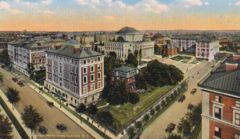Difference between revisions of "Morningside Heights campus"
(→External links) |
|||
| Line 12: | Line 12: | ||
== Historic buildings == | == Historic buildings == | ||
| + | |||
| + | [[History of the Morningside Heights campus]] | ||
Several buildings on the Morningside Heights campus are listed on the National Register of Historic Places. [[Low Memorial Library]], the centrepiece of the campus, is listed for its architectural significance. [[Philosophy Hall]] is listed as the site of the invention of FM radio. Also listed is [[Pupin Hall]], which houses the physics and astronomy departments, where initial experiments on the nuclear fission of uranium were conducted by Enrico Fermi. The uranium atom was split there ten days after the world's first atom-splitting in Copenhagen, Denmark. | Several buildings on the Morningside Heights campus are listed on the National Register of Historic Places. [[Low Memorial Library]], the centrepiece of the campus, is listed for its architectural significance. [[Philosophy Hall]] is listed as the site of the invention of FM radio. Also listed is [[Pupin Hall]], which houses the physics and astronomy departments, where initial experiments on the nuclear fission of uranium were conducted by Enrico Fermi. The uranium atom was split there ten days after the world's first atom-splitting in Copenhagen, Denmark. | ||
Revision as of 13:51, 10 March 2007

The Morningside Heights campus is the main graduate and undergraduate campus, in line with Seth Low's vision of a campus where all disciplines could be taught. It is located in Morningside Heights. The campus was designed along Beaux-Arts principles by acclaimed architects McKim, Mead, and White and is considered one of their best works. Its original open, urban feel has been somewhat modified by the addition of such buildings as Butler Library, which have served to almost fully enclose its interior open space.
Contents
Columbia properties
The campus occupies more than six city blocks, or 32 acres (132,000 m²). The university owns over 7,000 apartments in Morningside Heights, which house faculty, graduate students, and staff. Several undergraduate dormitories (purpose-built or converted) are also located in the surrounding neighborhood.
Construction and expansion issues
New buildings and structures on the campus, especially those built following the Second World War, have often only been constructed after a contentious process often involving open debate and protest over the new structures. Often the complaints raised by these protests during these periods of expansion have included issues beyond the debate over the construction of any of the architectural features which diverged from the original McKim, Mead, and White plan, and often involved complaints against the administration of the university. This was the case with Uris Hall, which sits behind Low Library, built in the 1960s, as well as the more recent Alfred Lerner Hall, a deconstructivist structure completed in 1998 and designed by Columbia's then-Dean of Architecture, Bernard Tschumi. Elements of these same issues have been reflected in the current debate over the future expansion of the campus into Manhattanville, several blocks uptown from the current campus.
Historic buildings
History of the Morningside Heights campus
Several buildings on the Morningside Heights campus are listed on the National Register of Historic Places. Low Memorial Library, the centrepiece of the campus, is listed for its architectural significance. Philosophy Hall is listed as the site of the invention of FM radio. Also listed is Pupin Hall, which houses the physics and astronomy departments, where initial experiments on the nuclear fission of uranium were conducted by Enrico Fermi. The uranium atom was split there ten days after the world's first atom-splitting in Copenhagen, Denmark.
Other campuses
Health-related schools are located at the Columbia University Medical Center, twenty acres located in the neighborhood of Washington Heights, fifty blocks uptown. Columbia also owns the 26-acre Baker Field, which includes the Lawrence A. Wien Stadium as well as facilities for field sports, outdoor track, tennis, and rowing at the northern tip of Manhattan island (in the neighborhood of Inwood). There is a third campus on the west bank of the Hudson River, the 157-acre Lamont-Doherty Earth Observatory in Palisades, New York, and another, the Nevis Laboratories, in Irvington, New York. The university also operates Reid Hall in Paris.
External links
- This page is largely based on Wikipedia's article about Columbia University.
- Awesome satellite photos of campus on Microsoft Live Search